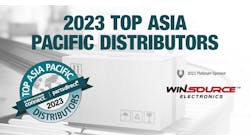Download this article in PDF format.
The imagery of a chain is a compelling one—interconnected links that are both flexible and strong. That strength is wholly dependent on those links remaining intact, however, and a supply chain is no different.
The breaks have come in several places in the supply chain over the past three years. It began with a trade war pitting the United States and China against one another. That was quickly followed by a global pandemic, inflationary pressures and a global shortage of workers to move those goods that were being produced.
Two more challenge are a deadly and disruptive invasion by Russia into Ukraine, which has halted the flow of oil, natural gas and precious metals across Europe, and a badly clogged port in Shanghai that has brought shipping to a standstill and is further exacerbated the worldwide supply system.
Any one of these challenges might be enough to dim the outlook for electronic distributors, but as the 2022 Source Today Top 50 Electronic Distributor Report demonstrates, the distributors are not just weathering the storm, but continuing to forge ahead.
2022 Top 50 Electronics Distributors List >
Revenues On The Rise
The top 20 electronics distributors that responded to the Source Today study reported revenue increases in 2021 at a time before inflationary cost increases began to take hold. While revenues from 2019 to 2020 remained largely flat, revenues in 2021 took a giant leap forward as distributors scaled the various supply hurdles and reconnected many portions of their supply network.
Arrow Electronics once again heads the Source Today Top 50 list with almost $34.5 billion in revenue in 2021, a 20% increase over 2020. After not participating in past years, Taiwan-based WPG Holdings Ltd. reported $27.8 billion in revenue to move into the second spot, with AVNET/Farrell in third position with $19.5 billion in revenues, a 19.5% increase from 2021.
All of the top 10 electronic distributors surveyed reported more than $1 billion in revenue and all reported double-digit growth rates from 2020. In the 2021 report, 11 companies had more than $1 billion in revenue and six more were between $500 million and $1 billion—or five more than in 2020.
Adapting To A Changed World
Increased revenues are only part of the story for the electronic distributors. In written interviews with Source Today, executives at some of the top distributors point to a willingness to continue to invest in people and technologies as one reason their business outlook remained strong despite the multiple challenges.
“If there is any silver lining to Covid it has caused all players in the supply chain to evaluate their resiliency and adaptability to non-linear events,” Doherty added. “Within Digi-Key, our model has always been built on selling from available inventory; in hindsight, a more simplistic model than we are faced with today.”
Investing In Technology
From cutting-edge systems to something as fundamental as sharpening a pencil, distributors are looking for ways to use technology to help the customers streamline their operations.
“Flip is currently updated systems, processes and tools to become even more nimble,” said Ittel. “Our business relies heavily on understanding what is going on at relative to Manufacturers change in portfolios and horizons. We spend a lot of time in analysis of the market, down to the device level. We are researching and adding tools all the time to help automate and drive efficiencies.”
“Visibility to real-time movements of both inbound and outbound shipments is critical to replenishing stock and ensuring customers receive orders on time,” said Doherty. “Visibility into costs is also becoming even more important than ever before as shipping costs are increasing. If it’s possible to pivot and find a less costly and faster way to ship, we’ll find it.
“For procurement professionals, having flexibility with a variety of shipping options is also of growing importance,” Doherty added. “For example, Digi-Key provides options to place scheduled orders to take advantage of price breaks and save time placing the same order repeatedly, and multi-ship consolidation to ship all orders together even if they’ve been placed on different days.”
“We continue to invest in technology,” said Burr-Lonnon. “In our Global Distribution Center, we now have 120 vertical lift modules. VLMs are essentially giant vertical filing cabinets, complete with shelves and an automated extractor to bring the components to the employee’s workstation. This increases efficiency and floor space and can reduce an employee’s walking time by 45% or more.”
“In the past 12 months, we have quadrupled the number of software engineers working on our systems,” LeSaffre said. “One-third of the department is dedicated to AI initiatives deriving predictive insights from product and market data, positioning us to stay ahead of market changes.”
2022 Top 50 Electronics Distributors List >
Feeling The Customers’ Pain
While revenues have grown and strategic investments have followed, the day-to-day challenges of the supply chain remain unresolved. It has had an impact on every aspect of manufacturing. The April 2022 report from the Institute for Supply Management saw another drop in the PMI Manufacturing Index. The index was at 60.8% in October 2021—more than 20% above the index’s growth level. In April, the PMI had slipped to 55.4%--still well above the 50% growth threshold for manufacturing, but well off its recent highs.
“The U.S. manufacturing sector remains in a demand-driven, supply chain-constrained environment. In April, progress slowed in solving labor shortage problems at all tiers of the supply chain,” said Timothy Fiore, chairman of the ISM Manufacturing Business Survey Committee in the monthly press release on the ISM data. “Panelists reported higher rates of quits compared to previous months, with fewer panelists reporting improvement in meeting head-count targets. April saw a slight easing of prices expansion, but instability in global energy markets continues.”
One chemical process distributor who contributes to the PMI report pointed to the dichotomy in the current manufacturing world. “Tier-2 supplier shutdowns in Shanghai are causing a ripple effect for our suppliers in other parts of China. Long delays at ports, including in the U.S., are still providing supply challenges. Inflation is out of control. Fuel costs, and therefore freight costs, are leading the upward cycle,” the distributor said in the press release. “At some point, the economy must give way; it will be tough to have real growth with such pressure on costs.” And then the distributor added, “Despite the issues and poor outlook, business remains brisk.”
Those attitudes are reflected in the distributors that Source Today interviewed. “In our current environment of tight supply and extended lead times, we encourage customers to create designs with components that can be sourced from multiple suppliers,” said Doherty. “Of course, they can’t do that for every part, but there are often ways to reconfigure a design in a few ways using different part numbers. Having a flexible bill of materials for parts with different manufacturers creates some insurance in the event that stock is not available.”
“Customers are naturally frustrated by the product shortages and are placing orders many months ahead,” said Burr-Lonnon. “Distributors are not immune to global factors and there have been extended lead times and restricted allocation on some of the more popular product lines. Our teams are closely monitoring shortages and are working closely with manufacturers to replenish products as quickly as possible.
“Despite the challenges, innovation continues. We are seeing exciting new sensor technologies, as well as the latest in power management and, of course, advancements in microprocessors, automotive, factory and home automation also will continue to be emerging markets as more technologies are introduced to make buildings, homes and vehicles smarter and safer,” Burr-Lonnon added. “Certainly, 5G, artificial intelligence, robotics, industrial automation and transportation are major growth drivers in the industry.”
“Most of our customers are trying to get the right mix of parts in to keep production commitments and lines going,” Ittel said. “They are challenged by the shortening life cycles of some technologies when the current technology will suffice for their products. They have to have a constant plan that is flexible and allows for them to develop ‘what if’ simulations on their production planning. Overall the demand is very robust without signs of letting up.”
“Shortages, rising costs, logistics challenges, gating items and related inventory buildups due to product mismatching, even cash flow and credit have all conspired to create a situation that is extremely uncomfortable for manufacturers,” said LeSaffre. “The protracted nature of this current market and little prospect for immediate improvement has maxed out supply chain managers and further dampened moods.”
But LeSaffre added, “The longer-term prospects for the industry similarly provide encouragement and vigor for efforts to overcome immediate obstacles. Current work addressing present day shortages is laying the groundwork for more resilient supply chains in the future.”
The Russian invasion of Ukraine and the continued aggression has shaken global markets in every possible way. The humanitarian crisis is at the forefront of the discussion, but the Russian invasion also has served to further roil the world’s supply chain.
Probably the greatest impact has been in the price of oil. This increase affects virtually all industries,” Ittel said. “Ukraine also supplies a large percentage of the neon that is used in lasers for semiconductor production.
“In the wake of turbulence that has hit the supply chain since early 2021, it seemed unfathomable that things could get worse,” LeSaffre added. “Yet, the war in Ukraine exacerbates existing pain points. Combined with a damaged logistics market, costs exacerbated by inflation and rising at a blistering pace, the entirety of long-term impacts from supply disruptions of key materials coming out of Ukraine will take some time to bear out.”
And Yet, Optimism Prevails
The stead revenue increases for electronics distributors point to strong management of these tangled supply chains and an equally strong relationship with customers. It is those attributes that have electronics distributors ready to grow despite the challenges, and perhaps even benefit from this short-term disruption.
“As we move forward, we are really looking at what high service means for both our customers and our suppliers,” said Doherty. “From a customer standpoint, our commitment to our core engineering audience is really getting them what they need better than anyone else and making it easier for them than anyone else. For our suppliers, we’re offering a lot of new options including our Marketplace and others. Everything we do is still rooted in what we do well and who we are, we’re just putting a finer point on it all and making sure those things are our key focus.”
“Expect to see continued growth in semiconductor products, even as those supply chains continue to be spotty, as well as other major product categories (interconnect, passives, electromechanical),” Burr-Lonnon added. “Engineering tools and new product introductions (NPIs) are two focus areas where we anticipate solid growth.”
“The crisis in Europe is just another market challenge. Distributors need to consistently think about adding value by paying attention to their customer's needs. Helping them grow is the key to success,” said Dufoe. “ At NewPower, we're always thinking about how technology can make us smarter, faster, and more efficient. We've positioned our nine offices globally so we can respond in real-time, in the local language.”
“The underlying demand for semiconductors is exciting and will only continue to grow. Technology is being incorporated into more and more of virtually all products. This bodes well,” Ittel said. “Hopefully, we can see a day soon with less pandemics, less wars and get back to some level of normalcy.”
“Despite the current supply chain instability and inflationary pressures, there are reasons for optimism and confidence as we look ahead to the future of the industry,” Burr-Lonnon said. “Projections call for robust demand for components, particularly in the data, communication and transportation sectors.
“Our customers have been very focused on building out redundancies and resiliency in their supply chains through creative inventory management programs,” LeSaffre said, “and we expect that part of our business to grow considerably, as holding more inventory becomes a major legacy of this shortage market.
“The current market has brought us closer to our customers,” LeSaffre added. “We have forged a number of deep and enduring partnerships in the wake of this crisis. We are encouraged about what our business will look like when the world eventually emerges from this ongoing crisis.”













